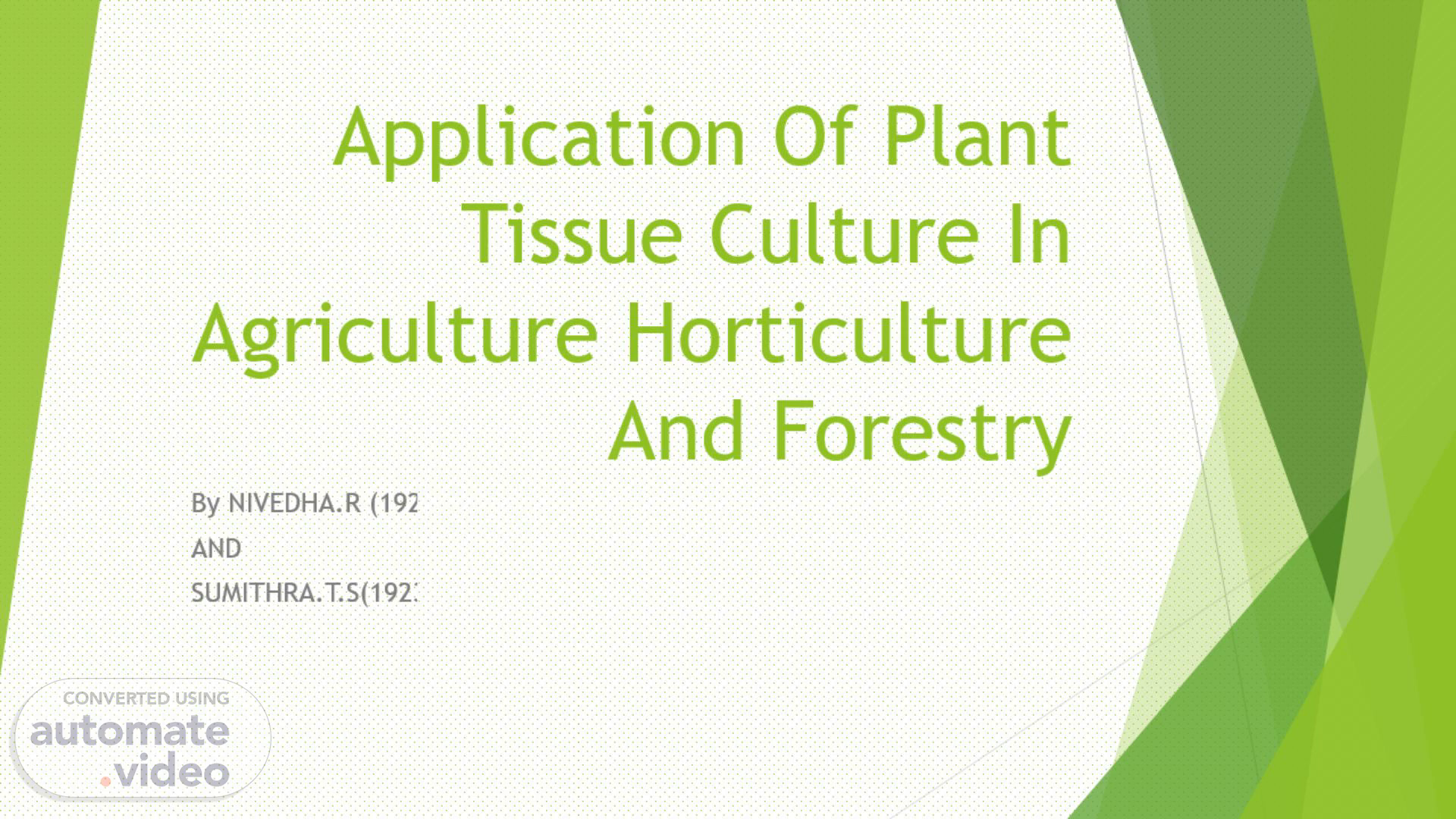
Page 1 (0s)
Application Of Plant Tissue Culture In Agriculture Horticulture And Forestry.
Page 2 (9s)
INTRODUCTION TO PLANT TISSUE CULTURE:. Plant tissue culture is a collection of techniques used to grow plants under sterile conditions on a nutrient culture medium..
Page 3 (27s)
BENEFITS OF PLANT TISSUE CULTURE:. Disease-Free Plants: Produces plants free from pathogens. Mass Propagation: Rapid multiplication of plants in a short time. Genetic Modification: Facilitates the development of plants with desirable traits..
Page 4 (41s)
OVERVIEW OF APPLICATIONS:. Agriculture Disease Resistance Drought and Salinity Tolerance Nutritional Enhancement Mass Propagation Germplasm Conservation Horticulture Ornamental Plants Commercial Floriculture Plant Breeding Forestry Reforestation and Afforestation Restoration of Degraded Lands Conservation of Endangered Species Improved Wood Quality.
Page 5 (1m 15s)
AGRICULTURE APPLICATIONS - DISEASE RESISTANCE:. Case Study 1: Disease-Resistant Banana Plants Background: Panama disease caused by Fusarium wilt devastated banana plantations. Solution: Tissue culture techniques used to develop and propagate disease-resistant banana varieties. Impact: Increased banana yields and reduced crop losses..
Page 6 (1m 31s)
AGRICULTURE APPLICATIONS - VIRUS-FREE PRODUCTION:.
Page 7 (1m 46s)
HORTICULTURE APPLICATIONS - ORCHID PROPAGATION:. Case Study 3: Orchid Propagation Background: Orchids are highly valued ornamental plants with slow natural propagation. Solution: Tissue culture techniques such as seed culture and micropropagation used for mass production. Impact: Large-scale production of orchids, making them more accessible and affordable..
Page 8 (2m 3s)
HORTICULTURE APPLICATIONS - NEW FLOWER VARIETIES:.
Page 9 (2m 21s)
FORESTRY APPLICATIONS – REFORESTATION:. Case Study 5: Reforestation with Fast-Growing Tree Species Background: Deforestation and the need for sustainable wood production. Solution: Tissue culture techniques used to propagate fast-growing and high-yielding tree species like eucalyptus and poplar . Impact: Enhanced reforestation efforts and sustainable timber production..
Page 10 (2m 38s)
FORESTRY APPLICATIONS – CONSERVATION:. Case Study 6: Conservation of Endangered Tree Species Background: Many tree species are endangered due to habitat loss and over-exploitation. Solution: Tissue culture methods employed for the conservation and reintroduction of endangered tree species into their natural habitats. Impact: Preservation of biodiversity and restoration of ecosystems..
Page 11 (2m 56s)
TECHNOLOGICAL ADVANCES:. Automated Systems: Use of robotics and automation for large-scale tissue culture production. Cryopreservation: Long-term storage of plant tissues at ultra-low temperatures for germplasm conservation. Genetic Engineering: Integration of tissue culture with genetic modification techniques to develop plants with improved traits..
Page 12 (3m 20s)
CHALLENGES:. High initial costs and technical expertise required. Risk of somaclonal variation leading to genetic instability..
Page 13 (3m 30s)
CONCLUSION:. Summary: Plant tissue culture is a powerful tool with significant applications in agriculture, horticulture, and forestry. Impact: Real-life case studies demonstrate its potential to enhance crop production, conserve biodiversity, and support sustainable practices. Future Outlook: Continued innovation and adoption of tissue culture techniques will drive further advancements in plant sciences..
Page 14 (3m 48s)
THANK YOU.